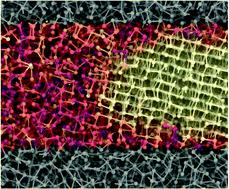Our official English website, www.x-mol.net, welcomes your
feedback! (Note: you will need to create a separate account there.)
Mechanism of amorphous phase stabilization in ultrathin films of monoatomic phase change material
Nanoscale ( IF 5.8 ) Pub Date : 2021-09-20 , DOI: 10.1039/d1nr03432d Daniele Dragoni 1 , Jörg Behler 2 , Marco Bernasconi 1
Nanoscale ( IF 5.8 ) Pub Date : 2021-09-20 , DOI: 10.1039/d1nr03432d Daniele Dragoni 1 , Jörg Behler 2 , Marco Bernasconi 1
Affiliation

|
Elemental antimony has been recently proposed as a promising material for phase change memories with improved performances with respect to the most used ternary chalcogenide alloys. The compositional simplification prevents reliability problems due to demixing of the alloy during memory operation. This is made possible by the dramatic stabilization of the amorphous phase once Sb is confined in an ultrathin film 3–5 nm thick. In this work, we shed light on the microscopic origin of this effect by means of large scale molecular dynamics simulations based on an interatomic potential generated with a machine learning technique. The simulations suggest that the dramatic reduction of the crystal growth velocity in the film with respect to the bulk is due to the effect of nanoconfinement on the fast β relaxation dynamics while the slow α relaxation is essentially unaffected.
中文翻译:

单原子相变材料超薄膜非晶相稳定机制
最近提出元素锑作为相变存储器的有前途的材料,相对于最常用的三元硫属化物合金具有改进的性能。成分的简化防止了由于在存储器操作期间合金的分层而引起的可靠性问题。一旦 Sb 被限制在 3-5 nm 厚的超薄膜中,非晶相的显着稳定性使这成为可能。在这项工作中,我们通过基于机器学习技术产生的原子间势的大规模分子动力学模拟揭示了这种效应的微观起源。模拟表明,薄膜中晶体生长速度相对于体积的显着降低是由于纳米限制对快β的影响弛豫动力学,而缓慢的α弛豫基本上不受影响。
更新日期:2021-09-20
中文翻译:

单原子相变材料超薄膜非晶相稳定机制
最近提出元素锑作为相变存储器的有前途的材料,相对于最常用的三元硫属化物合金具有改进的性能。成分的简化防止了由于在存储器操作期间合金的分层而引起的可靠性问题。一旦 Sb 被限制在 3-5 nm 厚的超薄膜中,非晶相的显着稳定性使这成为可能。在这项工作中,我们通过基于机器学习技术产生的原子间势的大规模分子动力学模拟揭示了这种效应的微观起源。模拟表明,薄膜中晶体生长速度相对于体积的显着降低是由于纳米限制对快β的影响弛豫动力学,而缓慢的α弛豫基本上不受影响。











































 京公网安备 11010802027423号
京公网安备 11010802027423号